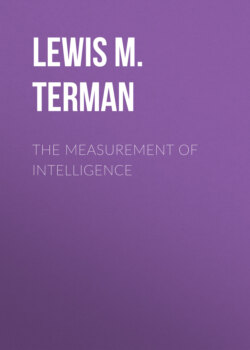Читать книгу The Measurement of Intelligence - Lewis M. Terman - Страница 12
На сайте Литреса книга снята с продажи.
Intelligence tests for vocational fitness.
ОглавлениеTable of Contents
The time is probably not far distant when intelligence tests will become a recognized and widely used instrument for determining vocational fitness. Of course, it is not claimed that tests are available which will tell us unerringly exactly what one of a thousand or more occupations a given individual is best fitted to pursue. But when thousands of children who have been tested by the Binet scale have been followed out into the industrial world, and their success in various occupations noted, we shall know fairly definitely the vocational significance of any given degree of mental inferiority or superiority. Researches of this kind will ultimately determine the minimum “intelligence quotient” necessary for success in each leading occupation.
Industrial concerns doubtless suffer enormous losses from the employment of persons whose mental ability is not equal to the tasks they are expected to perform. The present methods of trying out new employees, transferring them to simpler and simpler jobs as their inefficiency becomes apparent, is wasteful and to a great extent unnecessary. A cheaper and more satisfactory method would be to employ a psychologist to examine applicants for positions and to weed out the unfit. Any business employing as many as five hundred or a thousand workers, as, for example, a large department store, could save in this way several times the salary of a well-trained psychologist.
That the industrially inefficient are often of subnormal intelligence has already been demonstrated in a number of psychological investigations. Of 150 “hoboes” tested under the direction of the writer by Mr. Knollin, at least 15 per cent belonged to the moron grade of mental deficiency, and almost as many more were border-line cases. To be sure, a large proportion were found perfectly normal, and a few even decidedly superior in mental ability, but the ratio of mental deficiency was ten or fifteen times as high as that holding for the general population. Several had as low as 9- or 10-year intelligence, and one had a mental level of 7 years. The industrial history of such subjects, as given by themselves, was always about what the mental level would lead us to expect—unskilled work, lack of interest in accomplishment, frequent discharge from jobs, discouragement, and finally the “road.”
The above findings have been fully paralleled by Mr. Glenn Johnson and Professor Eleanor Rowland, of Reed College, who tested 108 unemployed charity cases in Portland, Oregon. Both of these investigators made use of the Stanford revision of the Binet scale, which is especially serviceable in distinguishing the upper-grade defectives from normals.
It hardly needs to be emphasized that when charity organizations help the feeble-minded to float along in the social and industrial world, and to produce and rear children after their kind, a doubtful service is rendered. A little psychological research would aid the united charities of any city to direct their expenditures into more profitable channels than would otherwise be possible.
